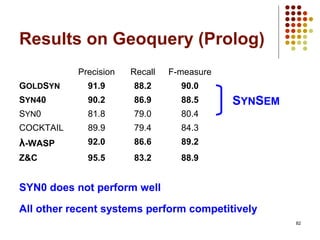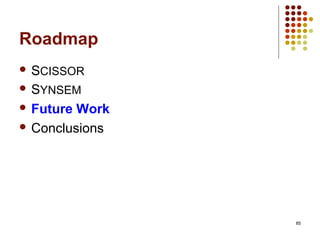Learning for semantic parsing using statistical syntactic parsing techniques
- 1. 1 Learning for Semantic Parsing Using Statistical Syntactic Parsing Techniques Ruifang Ge Ph.D. Final Defense Supervisor: Raymond J. Mooney Machine Learning Group Department of Computer Science The University of Texas at Austin
- 2. 2 Semantic Parsing Semantic Parsing: Transforming natural language (NL) sentences into completely formal meaning representations (MRs) Sample application domains where MRs are directly executable by another computer system to perform some task CLang: Robocup Coach Language Geoquery: A Database Query Application
- 3. 3 CLang (RoboCup Coach Language) In RoboCup Coach competition, teams compete to coach simulated players The coaching instructions are given in a formal language called CLang Simulated soccer field Coach If our player 2 has the ball, then position our player 5 in the midfield. CLang ((bowner (player our {2})) (do (player our {5}) (pos (midfield)))) Semantic Parsing
- 4. 4 GeoQuery: A Database Query Application Query application for U.S. geography database [Zelle & Mooney, 1996] User What are the rivers in Texas? Semantic Parsing DataBaseAngelina,Angelina, Blanco, …Blanco, … Query answer(x1, (river(x1), loc(x1,x2), equal(x2,stateid(texas))))
- 5. 5 Motivation for Semantic Parsing Theoretically, it answers the question of how people interpret language Practical applications Question answering Natural language interface Knowledge acquisition Reasoning
- 6. 6 Motivating Example Semantic parsing is a compositional process. Sentence structures are needed for building meaning representations. ((bowner (player our {2})) (do our {4} (pos (half our)))) If our player 2 has the ball, our player 4 should stay in our half bowner: ball owner pos: position
- 7. 7 Syntax-Based Approaches Meaning composition follows the tree structure of a syntactic parse Composing the meaning of a constituent from the meanings of its sub-constituents in a syntactic parse Hand-built approaches (Woods, 1970, Warren and Pereira, 1982) Learned approaches Miller et al. (1996): Conceptually simple sentences Zettlemoyer & Collins (2005)): hand-built Combinatory Categorial Grammar (CCG) template rules
- 8. 8 Example our player 2 has the ball PRP$ NN CD VB DT NN NP VPNP S MR: bowner(player(our,2)) Use the structure of a syntactic parse
- 9. 9 our player 2 has the ball PRP$-our NN-player(_,_) CD-2 VB-bowner(_) DT-null NN-null NP VPNP S Example MR: bowner(player(our,2)) Assign semantic concepts to words
- 10. 10 our player 2 has the ball PRP$-our NN-player(_,_) CD-2 VB-bowner(_) DT-null NN-null NP VPNP-player(our,2) S Example MR: bowner(player(our,2)) Compose meaning for the internal nodes
- 11. 11 our player 2 has the ball PRP$-our NN-player(_,_) CD-2 VB-bowner(_) DT-null NN-null NP-null VP-bowner(_)NP-player(our,2) S Example MR: bowner(player(our,2)) Compose meaning for the internal nodes
- 12. 12 our player 2 has the ball PRP$-our NN-player(_,_) CD-2 VB-bowner(_) DT-null NN-null NP-null VP-bowner(_)NP-player(our,2) S-bowner(player(our,2)) Example MR: bowner(player(our,2)) Compose meaning for the internal nodes
- 13. 13 Semantic Grammars Non-terminals in a semantic grammar correspond to semantic concepts in application domains Hand-built approaches (Hendrix et al., 1978) Learned approaches Tang & Mooney (2001), Kate & Mooney (2006), Wong & Mooney (2006)
- 14. 14 our player 2 has the ball our 2 player bowner Example MR: bowner(player(our,2)) bowner → player has the ball
- 15. 15 Thesis Contributions Introduce two novel syntax-based approaches to semantic parsing Theoretically well-founded in computational semantics (Blackburn and Bos, 2005) Great opportunity: leverage the significant progress made in statistical syntactic parsing for semantic parsing (Collins, 1997; Charniak and Johnson, 2005; Huang, 2008)
- 16. 16 Thesis Contributions SCISSOR: a novel integrated syntactic- semantic parser SYNSEM: exploits an existing syntactic parser to produce disambiguated parse trees that drive the compositional meaning composition Investigate when the knowledge of syntax can help
- 17. 17 Representing Semantic Knowledge in Meaning Representation Language Grammar (MRLG) Production Predicate CONDITION →(bowner PLAYER) P_BOWNER PLAYER →(player TEAM {UNUM}) P_PLAYER UNUM → 2 P_UNUM TEAM → our P_OUR Assumes a meaning representation language (MRL) is defined by an unambiguous context-free grammar. Each production rule introduces a single predicate in the MRL. The parse of a MR gives its predicate-argument structure.
- 18. 18 Roadmap SCISSOR SYNSEM Future Work Conclusions
- 19. 19 Semantic Composition that Integrates Syntax and Semantics to get Optimal Representations Integrated syntactic-semantic parsing Allows both syntax and semantics to be used simultaneously to obtain an accurate combined syntactic-semantic analysis A statistical parser is used to generate a semantically augmented parse tree (SAPT) SCISSOR
- 20. 20 Syntactic Parse PRP$ NN CD VB DT NN NP VPNP S our player 2 has the ball
- 21. 21 SAPT PRP$-P_OUR NN-P_PLAYER CD- P_UNUM VB-P_BOWNER DT-NULL NN-NULL NP-NULL VP-P_BOWNERNP-P_PLAYER S-P_BOWNER our player 2 has the ball Non-terminals now have both syntactic and semantic labels Semantic labels: dominate predicates in the sub-trees
- 22. 22 SAPT PRP$-P_OUR NN-P_PLAYER CD- P_UNUM VB-P_BOWNER DT-NULL NN-NULL NP-NULL VP-P_BOWNERNP-P_PLAYER S-P_BOWNER our player 2 has the ball MR: P_BOWNER(P_PLAYER(P_OUR,P_UNUM))
- 23. 23 SCISSOR Overview Integrated Semantic ParserSAPT Training Examples TRAINING learner
- 24. 24 Integrated Semantic Parser SAPT Compose MR MR NL Sentence TESTING SCISSOR Overview
- 25. 25 Extending Collins’ (1997) Syntactic Parsing Model Find a SAPT with the maximum probability A lexicalized head-driven syntactic parsing model Extending the parsing model to generate semantic labels simultaneously with syntactic labels
- 26. 26 Why Extending Collins’ (1997) Syntactic Parsing Model Suitable for incorporating semantic knowledge Head dependency: predicate-argument relation Syntactic subcategorization: a set of arguments that a predicate appears with Bikel (2004) implementation: easily extendable
- 27. 27 Parser Implementation Supervised training on annotated SAPTs is just frequency counting Testing: a variant of standard CKY chart- parsing algorithm Details in the thesis
- 28. 28 Smoothing Each label in SAPT is the combination of a syntactic label and a semantic label Increases data sparsity Break the parameters down Ph(H | P, w) = Ph(Hsyn, Hsem| P, w) = Ph(Hsyn | P, w) × Ph(Hsem| P, w, Hsyn)
- 29. 29 Experimental Corpora CLang (Kate, Wong & Mooney, 2005) 300 pieces of coaching advice 22.52 words per sentence Geoquery (Zelle & Mooney, 1996) 880 queries on a geography database 7.48 word per sentence MRL: Prolog and FunQL
- 30. 30 Prolog vs. FunQL (Wong, 2007) Prolog: answer(x1, (river(x1), loc(x1,x2), equal(x2,stateid(texas)))) What are the rivers in Texas? FunQL: answer(river(loc_2(stateid(texas)))) X1: river; x2: texas Logical forms: widely used as MRLs in computational semantics, support reasoning
- 31. 31 Prolog: answer(x1, (river(x1), loc(x1,x2), equal(x2,stateid(texas)))) What are the rivers in Texas? FunQL: answer(river(loc_2(stateid(texas)))) Flexible order Strict order Better generalization on Prolog Prolog vs. FunQL (Wong, 2007)
- 32. 32 Experimental Methodology standard 10-fold cross validation Correctness CLang: exactly matches the correct MR Geoquery: retrieves the same answers as the correct MR Metrics Precision: % of the returned MRs that are correct Recall: % of NLs with their MRs correctly returned F-measure: harmonic mean of precision and recall
- 33. 33 Compared Systems COCKTAIL (Tang & Mooney, 2001) Deterministic, inductive logic programming WASP (Wong & Mooney, 2006) Semantic grammar, machine translation KRISP (Kate & Mooney, 2006) Semantic grammar, string kernels Z&C (Zettleymoyer & Collins, 2007) Syntax-based, combinatory categorial grammar (CCG) LU (Lu et al., 2008) Semantic grammar, generative parsing model
- 34. 34 Compared Systems COCKTAIL (Tang & Mooney, 2001) Deterministic, inductive logic programming WASP (Wong & Mooney, 2006) Semantic grammar, machine translation KRISP (Kate & Mooney, 2006) Semantic grammar, string kernels Z&C (Zettleymoyer & Collins, 2007) Syntax-based, combinatory categorial grammar (CCG) LU (Lu et al., 2008) Semantic grammar, generative parsing model Hand-built lexicon for Geoquery Manual CCG Template rules
- 35. 35 Compared Systems COCKTAIL (Tang & Mooney, 2001) Deterministic, inductive logic programming WASP (Wong & Mooney, 2006) Semantic grammar, machine translation KRISP (Kate & Mooney, 2006) Semantic grammar, string kernels Z&C (Zettleymoyer & Collins, 2007) Syntax-based, combinatory categorial grammar (CCG) LU (Lu et al., 2008) Semantic grammar, generative parsing model λ-WASP, handling logical forms
- 36. 36 Results on CLang Precision Recall F-measure COCKTAIL - - - SCISSOR 89.5 73.7 80.8 WASP 88.9 61.9 73.0 KRISP 85.2 61.9 71.7 Z&C - - - LU 82.4 57.7 67.8 (LU: F-measure after reranking is 74.4%) Memory overflow Not reported
- 37. 37 Results on CLang Precision Recall F-measure SCISSOR 89.5 73.7 80.8 WASP 88.9 61.9 73.0 KRISP 85.2 61.9 71.7 LU 82.4 57.7 67.8 (LU: F-measure after reranking is 74.4%)
- 38. 38 Results on Geoquery Precision Recall F-measure SCISSOR 92.1 72.3 81.0 WASP 87.2 74.8 80.5 KRISP 93.3 71.7 81.1 LU 86.2 81.8 84.0 COCKTAIL 89.9 79.4 84.3 λ-WASP 92.0 86.6 89.2 Z&C 95.5 83.2 88.9 (LU: F-measure after reranking is 85.2%) Prolog FunQL
- 39. 39 Results on Geoquery (FunQL) Precision Recall F-measure SCISSOR 92.1 72.3 81.0 WASP 87.2 74.8 80.5 KRISP 93.3 71.7 81.1 LU 86.2 81.8 84.0 (LU: F-measure after reranking is 85.2%) competitive
- 40. 40 Why Knowledge of Syntax does not Help Geoquery: 7.48 word per sentence Short sentence Sentence structure can be feasibly learned from NLs paired with MRs Gain from knowledge of syntax vs. flexibility loss
- 41. 41 Limitation of Using Prior Knowledge of Syntax What state is the smallest N1 N2 answer(smallest(state(all))) Traditional syntactic analysis
- 42. 42 Limitation of Using Prior Knowledge of Syntax What state is the smallest state is the smallest N1 What N2 N1 N2 answer(smallest(state(all))) answer(smallest(state(all))) Traditional syntactic analysis Semantic grammar Isomorphic syntactic structure with MR Better generalization
- 43. 43 Why Prior Knowledge of Syntax does not Help Geoquery: 7.48 word per sentence Short sentence Sentence structure can be feasibly learned from NLs paired with MRs Gain from knowledge of syntax vs. flexibility loss LU vs. WASP and KRISP Decomposed model for semantic grammar
- 44. 44 Detailed Clang Results on Sentence Length 0-10 (7%) 11-20 (33%) 21-30 (46%) 31-40 (13%) 0-10 (7%) 11-20 (33%) 21-30 (46%) 0-10 (7%) 11-20 (33%) 31-40 (13%) 21-30 (46%) 0-10 (7%) 11-20 (33%)
- 45. 45 SCISSOR Summary Integrated syntactic-semantic parsing approach Learns accurate semantic interpretations by utilizing the SAPT annotations knowledge of syntax improves performance on long sentences
- 46. 46 Roadmap SCISSOR SYNSEM Future Work Conclusions
- 47. 47 SYNSEM Motivation SCISSOR requires extra SAPT annotation for training Must learn both syntax and semantics from same limited training corpus High performance syntactic parsers are available that are trained on existing large corpora (Collins, 1997; Charniak & Johnson, 2005)
- 48. 48 SCISSOR Requires SAPT Annotation PRP$-P_OUR NN-P_PLAYER CD- P_UNUM VB-P_BOWNER DT-NULL NN-NULL NP-NULL VP-P_BOWNERNP-P_PLAYER S-P_BOWNER our player 2 has the ball Time consuming. Automate it!
- 49. 49 Part I: Syntactic Parse PRP$ NN CD VB DT NN NP VPNP S our player 2 has the ball Use a statistical syntactic parser
- 50. 50 Part II: Word Meanings P_OUR P_PLAYER P_UNUM P_BOWNER NULL NULL our player 2 has the ball Use a word alignment model (Wong and Mooney (2006) ) our player 2 has ballthe P_PLAYERP_BOWNER P_OUR P_UNUM
- 51. 51 Learning a Semantic Lexicon IBM Model 5 word alignment (GIZA++) top 5 word/predicate alignments for each training example Assume each word alignment and syntactic parse defines a possible SAPT for composing the correct MR
- 52. 52 Introducing λvariables in semantic labels for missing arguments (a1: the first argument) our player 2 has ballthe VP S NP NP P_OUR λa1λa2P_PLAYER λa1P_BOWNER P_UNUM NULLNULL NP
- 53. 53 our player 2 has ballthe VP S NP NP P_OUR λa1λa2P_PLAYER λa1P_BOWNER P_UNUM NULLNULL P_BOWNER P_PLAYER P_UNUMP_OUR Part III: Internal Semantic Labels How to choose the dominant predicates? NP
- 54. 54 λa1λa2P_PLAYER P_UNUM ? player 2 P_BOWNER P_PLAYER P_UNUMP_OUR , a2=c2P_PLAYERλa1λa2PLAYER + P_UNUM λa1 (c2: child 2) Learning Semantic Composition Rules
- 55. 55 our player 2 has ballthe VP S NPP_OUR λa1λa2P_PLAYER λa1P_BOWNER P_UNUM NULLNULL λa1P_PLAYER ? λa1λa2PLAYER + P_UNUM {λa1P_PLAYER, a2=c2} P_BOWNER P_PLAYER P_UNUMP_OUR Learning Semantic Composition Rules
- 56. 56 our player 2 has ballthe VP S P_OUR λa1λa2P_PLAYER λa1P_BOWNER P_UNUM NULLNULL λa1P_PLAYER ? P_PLAYER P_OUR +λa1P_PLAYER {P_PLAYER, a1=c1} P_BOWNER P_PLAYER P_UNUMP_OUR Learning Semantic Composition Rules
- 57. 57 our player 2 has ballthe P_OUR λa1λa2P_PLAYER λa1P_BOWNER P_UNUM NULLNULL λa1P_PLAYER P_PLAYER NULL λa1P_BOWNER ? P_BOWNER P_PLAYER P_UNUMP_OUR Learning Semantic Composition Rules
- 58. 58 our player 2 has ballthe P_OUR λa1λa2P_PLAYER λa1P_BOWNER P_UNUM NULLNULL λa1P_PLAYER P_PLAYER NULL λa1P_BOWNER P_BOWNER P_PLAYER + λa1P_BOWNER {P_BOWNER, a1=c1} P_BOWNER P_PLAYER P_UNUMP_OUR Learning Semantic Composition Rules
- 59. 59 Ensuring Meaning Composition What state is the smallest N1 N2 answer(smallest(state(all))) Non-isomorphism
- 60. 60 Ensuring Meaning Composition Non-isomorphism between NL parse and MR parse Various linguistic phenomena Machine translation between NL and MRL Use automated syntactic parses Introduce macro-predicates that combine multiple predicates. Ensure that MR can be composed using a syntactic parse and word alignment
- 61. 61 Unambiguous CFG of MRL Training set, {(S,T,MR)} Training Semantic parsing Input sentence parse T Output MR Testing Before training & testing training/test sentence, S Syntactic parser syntactic parse tree,T Semantic knowledge acquisition Semantic lexicon & composition rules Parameter estimation Probabilistic parsing model SYNSEM Overview
- 62. 62 Unambiguous CFG of MRL Training set, {(S,T,MR)} Training Semantic parsing Input sentence, S Output MR Testing Before training & testing training/test sentence, S Syntactic parser syntactic parse tree,T Semantic knowledge acquisition Semantic lexicon & composition rules Parameter estimation Probabilistic parsing model SYNSEM Overview
- 63. 63 Parameter Estimation • Apply the learned semantic knowledge to all training examples to generate possible SAPTs • Use a standard maximum-entropy model similar to that of Zettlemoyer & Collins (2005), and Wong & Mooney (2006) • Training finds a parameter that (approximately) maximizes the sum of the conditional log-likelihood of the training set including syntactic parses • Incomplete data since SAPTs are hidden variables
- 64. 64 Features Lexical features: Unigram features: # that a word is assigned a predicate Bigram features: # that a word is assigned a predicate given its previous/subsequent word. Rule features: # a composition rule applied in a derivation
- 65. 65 answer(x1, (river(x1), loc(x1,x2), equal(x2,stateid(texas)))) What are the rivers in Texas? λv1P_ANSWER(x1) λv1P_RIVER(x1) λv1λv2P_LOC(x1,x2) λv1P_EQUAL(x2) Handling Logical Forms Handle shared logical variables Use Lambda Calculus (v: variable)
- 66. 66 Prolog Example answer(x1, (river(x1), loc(x1,x2), equal(x2,stateid(texas)))) What are the rivers in Texas? λv1P_ANSWER(x1) (λv1P_RIVER(x1) λv1 λv2P_LOC(x1,x2) λv1P_EQUAL(x2)) Handle shared logical variables Use Lambda Calculus (v: variable)
- 67. 67 Prolog Example answer(x1, (river(x1), loc(x1,x2), equal(x2,stateid(texas)))) What are the rivers in Texas? λv1P_ANSWER(x1) (λv1P_RIVER(x1) λv1λv2P_LOC(x1,x2) λv1P_EQUAL(x2)) Handle shared logical variables Use Lambda Calculus (v: variable)
- 68. 68 Prolog Example What are the rivers in Texas NP PP IN SBARQ NP NP SQ VBPWHNP answer(x1, (river(x1), loc(x1,x2), equal(x2,stateid(texas)))) Start from a syntactic parse
- 69. 69 Prolog Example What are the rivers in Texas PP SBARQ NP SQ λv1λa1P_ANSWER NULL λv1P_RIVER λv1λv2P_LOC λv1P_EQUAL Add predicates to words answer(x1, (river(x1), loc(x1,x2), equal(x2,stateid(texas))))
- 70. 70 Prolog Example What are the rivers in Texas SBARQ NP SQ λv1λa1P_ANSWER NULL λv1P_RIVER λv1λv2P_LOC λv1P_EQUAL λv1P_LOC answer(x1, (river(x1), loc(x1,x2), equal(x2,stateid(texas)))) Learn a rule with variable unification λv1λv2P_LOC(x1,x2) + λv1P_EQUAL(x2) λv1P_LOC
- 71. 71 Experimental Results CLang Geoquery (Prolog)
- 72. 72 Syntactic Parsers (Bikel,2004) WSJ only CLang(SYN0): F-measure=82.15% Geoquery(SYN0) : F-measure=76.44% WSJ + in-domain sentences CLang(SYN20): 20 sentences, F-measure=88.21% Geoquery(SYN40): 40 sentences, F-measure=91.46% Gold-standard syntactic parses (GOLDSYN)
- 73. 73 Questions Q1. Can SYNSEM produce accurate semantic interpretations? Q2. Can more accurate Treebank syntactic parsers produce more accurate semantic parsers? Q3. Does it also improve on long sentences? Q4. Does it improve on limited training data due to the prior knowledge from large treebanks? Q5. Can it handle syntactic errors?
- 74. 74 Results on CLang Precision Recall F-measure GOLDSYN 84.7 74.0 79.0 SYN20 85.4 70.0 76.9 SYN0 87.0 67.0 75.7 SCISSOR 89.5 73.7 80.8 WASP 88.9 61.9 73.0 KRISP 85.2 61.9 71.7 LU 82.4 57.7 67.8 (LU: F-measure after reranking is 74.4%) SYNSEM SAPTs GOLDSYN > SYN20 > SYN0
- 75. 75 Questions Q1. Can SynSem produce accurate semantic interpretations? [yes] Q2. Can more accurate Treebank syntactic parsers produce more accurate semantic parsers? [yes] Q3. Does it also improve on long sentences?
- 76. 76 Detailed Clang Results on Sentence Length 31-40 (13%) 21-30 (46%) 0-10 (7%) 11-20 (33%) Prior Knowledge Syntactic error + Flexibility + = ?
- 77. 77 Questions Q1. Can SynSem produce accurate semantic interpretations? [yes] Q2. Can more accurate Treebank syntactic parsers produce more accurate semantic parsers? [yes] Q3. Does it also improve on long sentences? [yes] Q4. Does it improve on limited training data due to the prior knowledge from large treebanks?
- 78. 78 Results on Clang (training size = 40) Precision Recall F-measure GOLDSYN 61.1 35.7 45.1 SYN20 57.8 31.0 40.4 SYN0 53.5 22.7 31.9 SCISSOR 85.0 23.0 36.2 WASP 88.0 14.4 24.7 KRISP 68.35 20.0 31.0 SYNSEM SAPTs The quality of syntactic parser is critically important!
- 79. 79 Questions Q1. Can SynSem produce accurate semantic interpretations? [yes] Q2. Can more accurate Treebank syntactic parsers produce more accurate semantic parsers? [yes] Q3. Does it also improve on long sentences? [yes] Q4. Does it improve on limited training data due to the prior knowledge from large treebanks? [yes] Q5. Can it handle syntactic errors?
- 80. 80 Handling Syntactic Errors Training ensures meaning composition from syntactic parses with errors For test NLs that generate correct MRs, measure the F-measures of their syntactic parses SYN0: 85.5% SYN20: 91.2% If DR2C7 is true then players 2 , 3 , 7 and 8 should pass to player 4
- 81. 81 Questions Q1. Can SynSem produce accurate semantic interpretations? [yes] Q2. Can more accurate Treebank syntactic parsers produce more accurate semantic parsers? [yes] Q3. Does it also improve on long sentences? [yes] Q4. Does it improve on limited training data due to the prior knowledge of large treebanks? [yes] Q5. Is it robust to syntactic errors? [yes]
- 82. 82 Results on Geoquery (Prolog) Precision Recall F-measure GOLDSYN 91.9 88.2 90.0 SYN40 90.2 86.9 88.5 SYN0 81.8 79.0 80.4 COCKTAIL 89.9 79.4 84.3 λ-WASP 92.0 86.6 89.2 Z&C 95.5 83.2 88.9 SYNSEM SYN0 does not perform well All other recent systems perform competitively
- 83. 83 SYNSEM Summary Exploits an existing syntactic parser to drive the meaning composition process Prior knowledge of syntax improves performance on long sentences Prior knowledge of syntax improves performance on limited training data Handle syntactic errors
- 84. 84 Discriminative Reranking for semantic Parsing Adapt global features used for reranking syntactic parsing for semantic parsing Improvement on CLang No improvement on Geoquery where sentences are short, and are less likely for global features to show improvement on
- 85. 85 Roadmap SCISSOR SYNSEM Future Work Conclusions
- 86. 86 Future Work Improve SCISSOR Discriminative SCISSOR (Finkel, et al., 2008) Handling logical forms SCISSOR without extra annotation (Klein and Manning, 2002, 2004) Improve SYNSEM Utilizing syntactic parsers with improved accuracy and in other syntactic formalism
- 87. 87 Future Work Utilizing wide-coverage semantic representations (Curran et al., 2007) Better generalizations for syntactic variations Utilizing semantic role labeling (Gildea and Palmer, 2002) Provides a layer of correlated semantic information
- 88. 88 Roadmap SCISSOR SYNSEM Future Work Conclusions
- 89. 89 Conclusions SCISSOR: a novel integrated syntactic-semantic parser. SYNSEM: exploits an existing syntactic parser to produce disambiguated parse trees that drive the compositional meaning composition. Both produce accurate semantic interpretations. Using the knowledge of syntax improves performance on long sentences. SYNSEM also improves performance on limited training data.
Editor's Notes
- #20: Insert an outline slides for scissor overview, integrated model(augment Collins’s parsemodel), experiment Each internal node includes both a syntactic and semantic label SAPT captures the semantic interpretation of individual words and the basic predicate-argument structure of the sentence
- #24: Animiation Training Examples Parser
- #25: Animiation Training Examples Parser

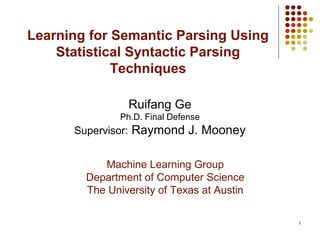

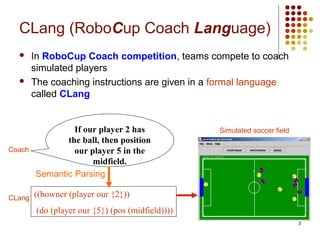
![4
GeoQuery: A Database Query Application
Query application for U.S. geography
database [Zelle & Mooney, 1996]
User What are the
rivers in Texas?
Semantic Parsing
DataBaseAngelina,Angelina,
Blanco, …Blanco, …
Query answer(x1, (river(x1), loc(x1,x2),
equal(x2,stateid(texas))))](https://image.slidesharecdn.com/learningforsemanticparsingusingstatisticalsyntacticparsingtechniques-140420235415-phpapp02/85/Learning-for-semantic-parsing-using-statistical-syntactic-parsing-techniques-4-320.jpg)
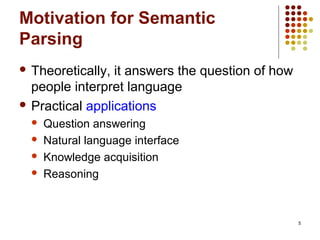
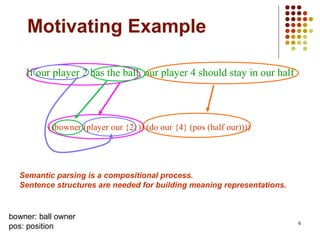
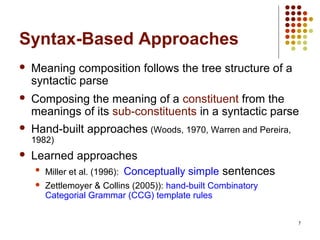
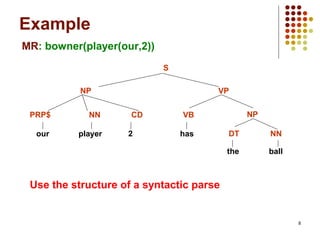
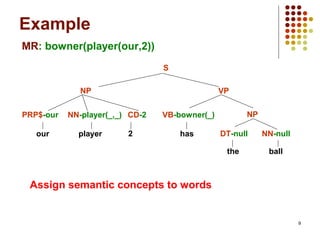
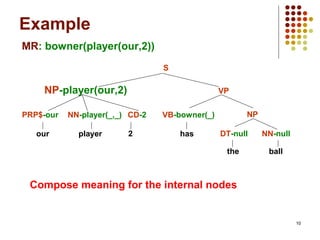
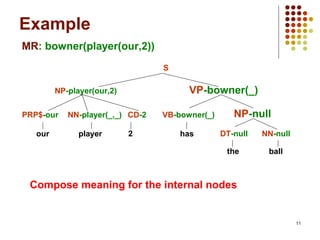
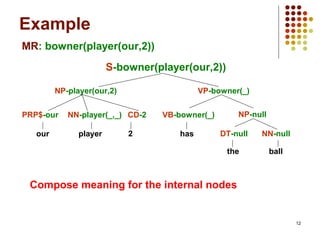
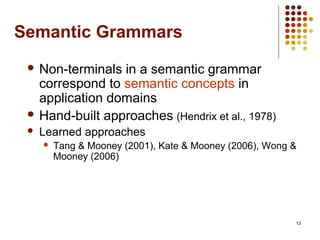
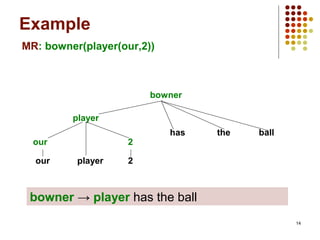
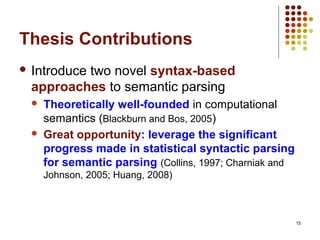
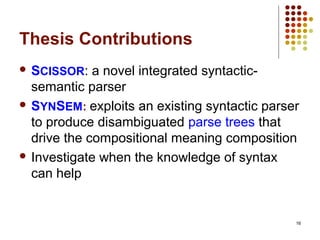
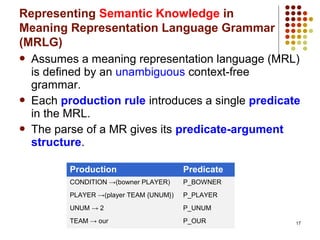
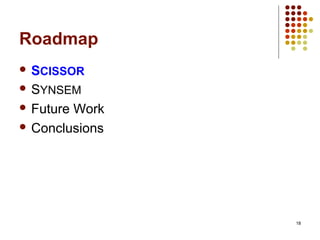

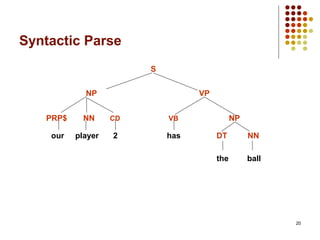
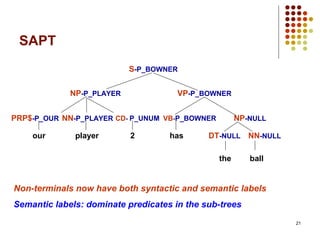
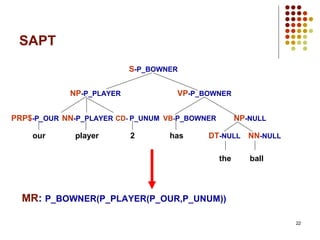

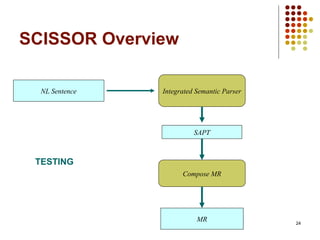

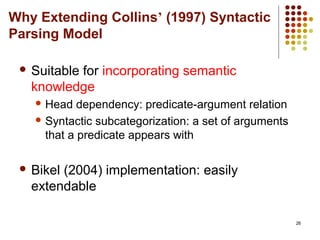





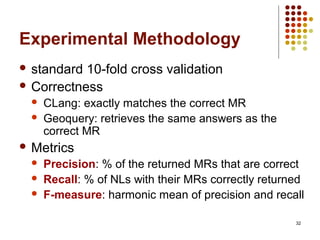


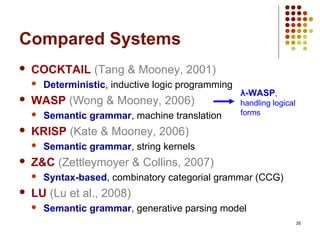



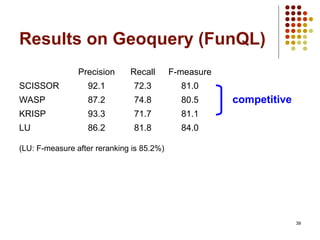
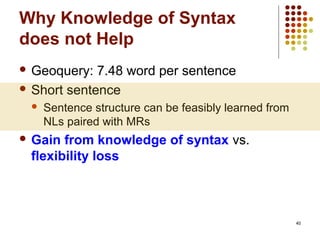
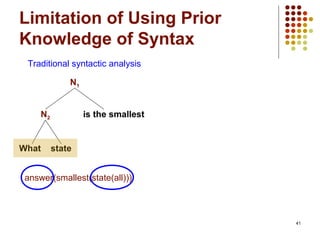
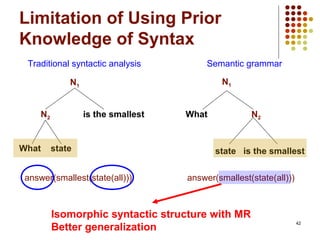




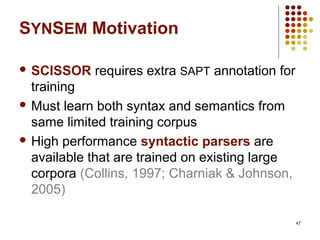
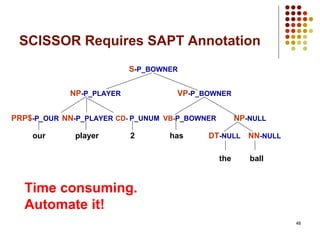


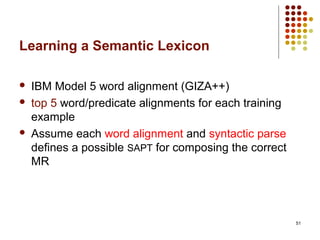

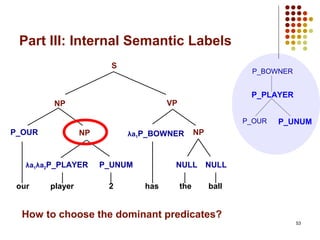













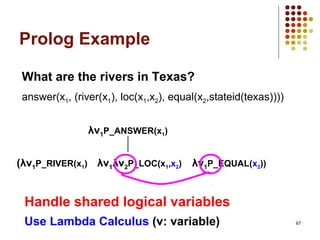

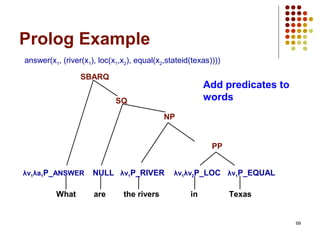
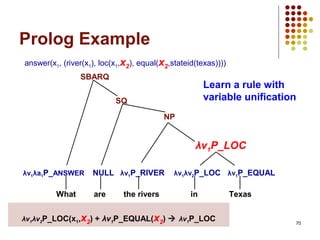
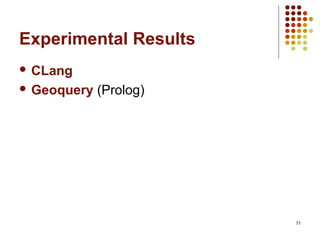
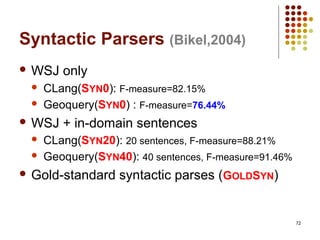
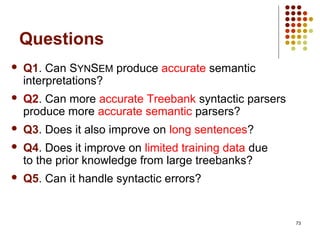
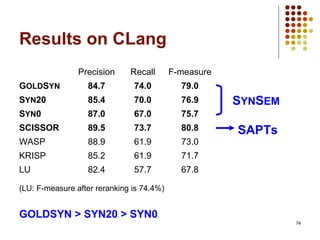
![75
Questions
Q1. Can SynSem produce accurate semantic
interpretations? [yes]
Q2. Can more accurate Treebank syntactic parsers
produce more accurate semantic parsers? [yes]
Q3. Does it also improve on long sentences?](https://image.slidesharecdn.com/learningforsemanticparsingusingstatisticalsyntacticparsingtechniques-140420235415-phpapp02/85/Learning-for-semantic-parsing-using-statistical-syntactic-parsing-techniques-75-320.jpg)

![77
Questions
Q1. Can SynSem produce accurate semantic
interpretations? [yes]
Q2. Can more accurate Treebank syntactic parsers
produce more accurate semantic parsers? [yes]
Q3. Does it also improve on long sentences? [yes]
Q4. Does it improve on limited training data due
to the prior knowledge from large treebanks?](https://image.slidesharecdn.com/learningforsemanticparsingusingstatisticalsyntacticparsingtechniques-140420235415-phpapp02/85/Learning-for-semantic-parsing-using-statistical-syntactic-parsing-techniques-77-320.jpg)

![79
Questions
Q1. Can SynSem produce accurate semantic
interpretations? [yes]
Q2. Can more accurate Treebank syntactic parsers
produce more accurate semantic parsers? [yes]
Q3. Does it also improve on long sentences? [yes]
Q4. Does it improve on limited training data due
to the prior knowledge from large treebanks? [yes]
Q5. Can it handle syntactic errors?](https://image.slidesharecdn.com/learningforsemanticparsingusingstatisticalsyntacticparsingtechniques-140420235415-phpapp02/85/Learning-for-semantic-parsing-using-statistical-syntactic-parsing-techniques-79-320.jpg)
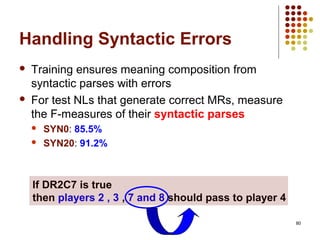
![81
Questions
Q1. Can SynSem produce accurate semantic
interpretations? [yes]
Q2. Can more accurate Treebank syntactic parsers
produce more accurate semantic parsers? [yes]
Q3. Does it also improve on long sentences? [yes]
Q4. Does it improve on limited training data due
to the prior knowledge of large treebanks? [yes]
Q5. Is it robust to syntactic errors? [yes]](https://image.slidesharecdn.com/learningforsemanticparsingusingstatisticalsyntacticparsingtechniques-140420235415-phpapp02/85/Learning-for-semantic-parsing-using-statistical-syntactic-parsing-techniques-81-320.jpg)
